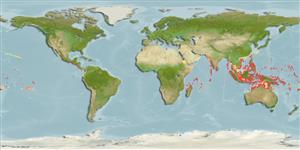Common names from other countries
Environment: milieu / climate zone / depth range / distribution range
Ecologia
marino associati a barriera corallina; distribuzione batimetrica 1 - 40 m (Ref. 9710). Tropical; 32°N - 18°S
Indo-Pacific: Mauritius, Reunion, Maldives and Sri Lanka (Ref. 33390) to the Society Islands, north to southern Japan, south to Scott Reef.
Size / Peso / Age
Maturity: Lm ? range ? - ? cm
Max length : 13.0 cm TL maschio/sesso non determinato; (Ref. 48635)
Spine dorsali (totale) : 13; Raggi dorsali molli (totale) : 9; Spine anali: 3; Raggi anali molli: 5. Eye-like spots in the soft dorsal fin and feeler-like tentacles in front of the mouth (Ref. 48635). Mid-dorsal spines shorter than body depth. The only species of Dendrochirus with a pair of distinct ocelli on the soft-rayed dorsal fin (Ref. 37816).
An uncommon inhabitant of clear waters rich in corals to depths of 40 m or more. Feeds on small fishes and crustaceans (Ref. 89972). Secretive and usually observed at night. During the day in caves and sponges, and usually well out of sight (Ref. 48635). Venomous spines.
Life cycle and mating behavior
Maturities | Riproduzione | Spawnings | Egg(s) | Fecundities | Larve
Myers, R.F., 1991. Micronesian reef fishes. Second Ed. Coral Graphics, Barrigada, Guam. 298 p. (Ref. 1602)
IUCN Red List Status (Ref. 130435)
CITES (Ref. 128078)
Not Evaluated
Human uses
Pesca: commerciale; Acquario: Commerciale
Strumenti
Special reports
Download XML
Fonti Internet
Estimates based on models
Preferred temperature (Ref.
115969): 26.6 - 28.9, mean 28 (based on 432 cells).
Phylogenetic diversity index (Ref.
82804): PD
50 = 0.5078 [Uniqueness, from 0.5 = low to 2.0 = high].
Bayesian length-weight: a=0.01023 (0.00444 - 0.02358), b=3.01 (2.82 - 3.20), in cm Total Length, based on LWR estimates for this (Sub)family-body shape (Ref.
93245).
Trophic level (Ref.
69278): 3.7 ±0.6 se; based on size and trophs of closest relatives
Resilienza (Ref.
120179): Alto, tempo minimo di raddoppiamento della popolazione meno di 15 mesi (Preliminary K or Fecundity.).
Fishing Vulnerability (Ref.
59153): Low vulnerability (10 of 100).
